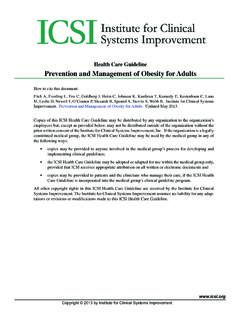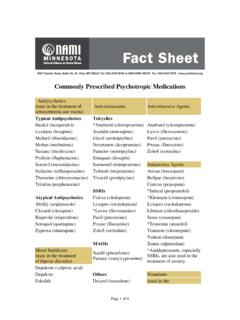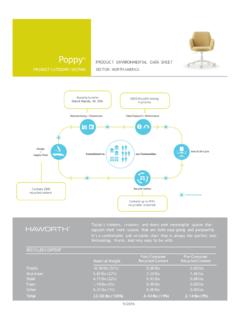Transcription of Interpretation of Opiate Urine Drug Screens - HealthPartners
1 Interpretation of Opiate Urine drug Screens Summary Urine drug testing is highly reliable, but false positives can rarely occur for some drugs. As always, clinical judgment is necessary when interpreting test results. The length of time a drug can be detected in the Urine varies due to several factors, including hydration, dosing, metabolism, body mass, Urine pH, duration of use, and a drug s particular pharmacokinetics. (See table below for some average times for different drugs.) Length of Time Drugs of Abuse Can Be Detected in UrineDrug Time Alcohol 7-12 h Amphetamine 48 h Methamphetamine 48 h Barbiturate Short-acting (eg, pentobarbital) 24 h Long-acting (eg, phenobarbitol) 3 wk Benzodiazepine Short-acting (eg, lorazepam) 3 d Long-acting (eg, diazepam) 30 d Cocaine metabolites 2-4 d Marijuana Single use 3 d Moderate use (4 times/wk) 5-7 d Daily use 10-15 d Long-term heavy smoker 30 d Opioids Codeine 48 h Heroin (detected as morphine) 48 h Hydromorphone 2-4 d Methadone 3 d Morphine 48-72 h Oxycodone 2-4 d Propoxyphene 6-48 h Phencyclidine 8 d -- Mayo Clinic Proc.
2 2008; 83(1)66-76 Sometimes the specific drug ingested is not detected, but instead one of its metabolites is found. Opiate /Opioid Metabolism Two types of Urine drug tests are used for HealthPartners patients immunoassay and gas chromatography-mass spectrometry (GC/MS). The first test done is the immunoassay. This can be susceptible to false positives, so when a positive result is obtained it is confirmed by the pain management Urine drug screen,/MS is done for these drugs regardless of the immunoassay screen result: morphine, codeine, oxycodone, oxymorphone, hydrocodone, hydromorphone. The GC/MS confirmation assays are highly reliable and specific tests with very rare interferences. Fentanyl (Duragesic) is not easily detected in either Urine or serum.
3 Our current system does not allow accurate determination of the presence of this drug . HealthPartners may purchase new equipment that will make this possible within the next year. Until that happens, you will not be able to tell whether a patient is using fentanyl (Duragesic patches) based on the results of the Urine drug screen. Discussion Current Urine drug testing methods were designed to identify illicit use of drugs in the forensic or occupational setting. In this setting, high specificity was needed to avoid a false positive result and this was carried out by using a relatively high cutoff concentration needed to trigger a positive result. In the setting of pain management compliance testing, both drug pharmacokinetics (how the body acts on a drug ) and testing limitations that affect the results of Urine testing must be understood for proper Interpretation .
4 Although the name Opiate is often used to describe any member of the class of drugs that acts on opioid receptors, the term Opiate properly refers to the natural alkaloids found in opium poppy resin (Papaver somniferum), which include morphine, codeine and thebaine. The term opioid refers to the synthetic and semi-synthetic opioid receptor drugs, including heroin, hydromorphone, hydrocodone, oxycodone, oxymorphone, buprenorphine, fentanyl, and methadone. Codeine Heroin Oxycodone Hydrocodone Morphine 6-AM Hydromorphone Oxymorphone Dihydrocodeine drug Half-life (hr) Metabolites Concentrations above the cutoff will screen positive for morphine - normorphine, hydromorphone (< ) Opiates codeine 1 - 4 morphine, hydrocodone (<11%), norcodeine Opiates oxycodone 4 - 12 oxymorphone, noroxycodone Oxycodone oxymorphone 3 - 6 6-hydroxy-oxymorphone Oxycodone hydrocodone - 9 hydromorphone, norhydrocodone, dihydrocodeine Opiates hydromorphone 3 - 9 hydromorphol Opiates * bolded metabolites are identical to pharmaceutically available drugs Assay Technologies The pain management Urine drug screen offered within the HealthPartners Family of Care consists of two steps.
5 First, a qualitative (positive/negative) immunoassay screen is completed, including tests for opiates (300 ng/mL cutoff), oxycodone (100 ng/mL cutoff), amphetamine, barbiturate, benzodiazepines, cocaine, methadone, PCP, propoxyphene, and THC. These drugs are reported as positive if they are present at a concentration above the designated cutoff (see Regions Hospital Laboratory Toxicology website on myPartner for specific cutoffs and drugs detected) and confirmed as positive by GC/MS. For the pain management panel only, regardless of the screen results, GC/MS confirmation for the following drugs are completed and reported individually as positive/negative with a detection limit of 100 ng/mL: morphine, codeine, oxycodone, oxymorphone, hydrocodone, hydromorphone.
6 This allows for higher sensitivity and specificity along with offering results for each drug individually. In general, immunoassay technologies are susceptible to interfering substances (false positives) and cross-reactivity (true positives for non-target drugs, due to structural similarity) to varying degrees. Accordingly, each result needs to be interpreted in the context of the clinical picture and in conjunction with our confirmatory method of gas chromatography/mass spectrometry (GC/MS). The immunoassay for opiates is primarily targeted to detecting morphine, hydrocodone, dihydrocodeine, codeine, 6-acetylmorphine (metabolite of heroin), and hydromorphone. Due to that assay s insensitivity for oxycodone, the oxycodone assay is utilized to detect oxycodone and oxymorphone.
7 The GC/MS confirmation assays are highly reliable and specific tests with very rare interferences. Detection Windows The window to detect the presence of a particular drug in a person s Urine is highly dependent on multiple factors, such as: Hydration - More dilute Urine from high fluid intake may cause dilution of drug and therefore a negative result due to levels present but below the cutoff. Conversely, a patient may greatly reduce fluid intake in order to concentrate their Urine when trying to mask inappropriate reduced intake of their prescribed drug . Dosing - If a patient is on a low dose or has a long interval between doses, the level of drug in their Urine may be too low to be detected by the immunoassay or confirmation assay, below the cutoff.
8 Similarly, the time between the last dose of a drug taken and the collection of the Urine specimen may affect if the drug is present at concentrations adequate to produce a positive result. Metabolism - Metabolism is unique to each individual, determined by genetic and environmental factors. Genetic polymorphisms of the CYP450 2D6 enzyme can cause individuals to be poor or rapid metabolizers of opioids and other drugs metabolized by those enzymes1. Additionally, environmental influences further complicate metabolism. For example, co-administered drugs that are also metabolized by CYP450 enzymes used by the opioids or that inhibit CYP450 2D6 cause decreased metabolism, see Table below. Conversely, rifampin and dexamethasone are known to induce CYP450 2D6, causing increased metabolism of opioids with a resulting shortened detection window.
9 Other factors affecting metabolism include age, sex, ethnicity, and renal or liver impairment. Other Factors The detection window of a drug is also affected by: duration of use, body mass, Urine pH and a drug s particular chemistry, half-life and volume of distribution. If a negative result is obtained for a drug prescribed to the patient, the entire clinical picture must be taken into consideration to determine if the patient was: 1) not taking the drug , 2) taking a lower dose than instructed, or 3) taking the drug properly but the results were negative due to one of above factors. Similarly, if a positive result is obtained for a drug not prescribed to the patient, the entire clinical picture must be taken into consideration to determine if the patient was taking the non-prescribed drug , has a false positive result (applies to immunoassay only) or if the drug is simply a metabolite of a prescribed drug (as applicable).
10 The following figure exemplifies the amount of variation possible in the concentration of drug present in individuals taking the same dose of a drug2. In this example, 36 healthy participants that had taken no drugs in the previous 30 days were given one of 3 doses (n=12 per dose) of OxyContin . The following shows the combined distribution of multiple Urine specimens taken from each individual days 3 and 4 after dosing began: Interpretation Cautions Interferents, sensitivity and cutoffs vary by immunoassay, see Reference 3 for a review of immunoassay types and interferents; EMIT assays are used by Regions Hospital s Toxicology lab, which serves the entire HP Family of Care. Hydromorphone has been shown to be a minor metabolite in chronic pain patients receiving high amounts of ,5 Hydrocodone has been shown to be a minor metabolite detectable in patients on high amounts of codeine6; as the metabolite of hydrocodone, hydromorphone may also be detectable in these cases.



















